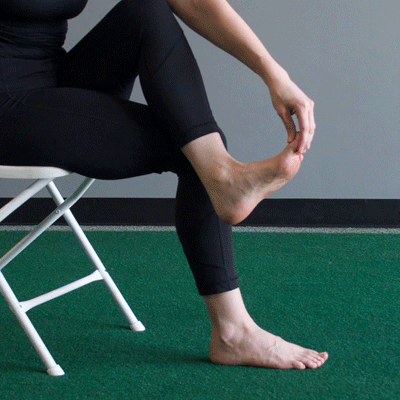Plantar Fasciitis Stretches to Soothe Heel Pain

What is plantar fasciitis?
You probably never thought much about your plantar fascia until the pain in your heel jolted you. A thin ligament that connects your heel to the front of your foot, the plantar fascia, can be a trouble spot for many people. Heel pain affects more than 50 percent of Americans, and the most common cause is plantar fasciitis. Repetitive motion from running or step aerobics, or added pressure from weight gain can damage or tear the plantar fascia, causing inflammation and pain.
Along with runners, plantar fasciitis is common among pregnant women because the extra weight on the ligament can cause inflammation, leading to pain. If you have heel pain, don’t be discouraged. There are simple steps you can take to ease the pain so that you can resume running or another exercise.
Stretching solutions
Taut muscles in your feet or calves aggravate plantar fasciitis. Soothe or prevent the pain with some of these easy stretches recommended by personal trainer and triathlete Deborah Lynn Irmas of Santa Monica, CA. Irmas is certified by the American Council on Exercise (ACE). She endured bouts of plantar fasciitis after overtraining with too many sprints. This stretching routine, which she practices and recommends to her clients, keeps her free of heel pain.
Stretch your calves
- Stand an arm’s length from a wall.
- Place your right foot behind your left.
- Slowly and gently bend your left leg forward.
- Keep your right knee straight and your right heel on the ground.
- Hold the stretch for 15 to 30 seconds and release. Repeat three times.
- Reverse the position of your legs, and repeat.

This stretch targets the gastrocnemius muscle in your calf. As your plantar fascia begins to heal and the pain diminishes, you can deepen this stretch by performing it with both legs slightly bent, says Irmas. Done this way, the stretch loosens the soleus muscle in the lower calf. Irmas cautions that it’s important not to hold the stretches for too long.
Grab a chair and stretch your plantar fascia

These three seated stretching exercises will also help relieve plantar fasciitis. Remember to sit up straight while you do them:
- While seated, roll your foot back and forth over a frozen water bottle, ice-cold can, or foam roller. Do this for one minute and then switch to the other foot.
- Next, cross one leg over the other for the big toe stretch. Grab your big toe, pull it gently toward you, and hold for 15 to 30 seconds. Do this three times, then reverse and do the same with the other foot.
- For the third seated exercise, fold a towel lengthwise to make an exercise strap. Sit down, and place the folded towel under the arches of both feet. Grab the ends of the towel with both hands, and gently pull the tops of your feet toward you. Hold for 15 to 30 seconds, and repeat three times.
Not only can these stretches help to reduce heel pain, but doing them faithfully before your workout “absolutely can prevent plantar fasciitis,” says Irmas.
Some other tips and precautions

Ease up
You’ll need to give running a rest until the inflammation in your plantar fascia calms down. Runners heal at different paces, but Irmas generally suggests taking about two weeks off. Ice your plantar fascia, perform the stretches, and take an anti-inflammatory medication like ibuprofen if you need it.

Start slowly
When rest and ice have alleviated your heel pain, then you can try “tiny runs,” Irmas says. “Run a short distance slowly, like from one telephone pole to the next. Stop at each telephone pole to stretch.” Lengthen the runs gradually by running the distance between two telephone poles, two houses, two trees, or other markers you identify on your route. Continue to stop at each marker and punctuate your run with calf stretches, Irmas says.
More support
While rest and regular stretching help mend plantar fasciitis, be sure you have sturdy shoes when you get back out there for your runs. The American Academy of Orthopaedic Surgeons points out that adequate support and proper fit are also important to avoid heel pain and prevent other running-related injuries. Be sure to buy new shoes as frequently as you need to so that they provide the support and cushion your body needs to stay free of injury.
Discover more from ReviewFitHealth.com
Subscribe to get the latest posts sent to your email.